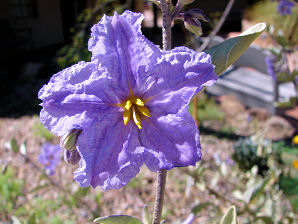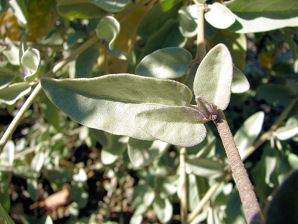Xeriscape Landscaping Plants For The Arizona Desert Environment.
Pictures, Photos, Information
Descriptions, Images, & Reviews.
Shrubs.
Blue Solanum Shrub, Solanum hindsianum.
We Are Proud Of Our SafeSurf Rating!
Click On Any Of The Following Links By Amazon.Com
For Books, & Videos About Wildflowers Of Arizona & The Southwest USA. No Obligation!
 |
| Blue Solanum Shrub, Solanum hindsianum. Photo Taken March 3, 2008. Phoenix Arizona Desert Botanical Garden. |
|---|
 |  |
| Blue Solanum Shrub. Solanum hindsianum. | Blue Solanum Shrub. Solanum hindsianum. |
|---|
Blue Solanum Shrub.
We wish to thank Wikipedia, the free encyclopedia for some of the information on this page. We share images and information with Wikipedia. Herb, Perennial, native to Pima county Arizona, & Sonora, Baja California, & Baja California Sur, Mexico. Solanum hindsianum is a summer-growing perennial plant, with a very extensive root system. Its roots can grow very deep ( 6 to 10 feet ) and extend horizontally to produce shoots up to 6 feet away from the parent plant. Shoots begin to emerge from established plants as soon as the soil warms during late March to early April. Plants may begin to flower in early May. Ripe fruits may be present in June, and some seeds are viable during the same season they are produced. Seedlings can appear during August & September in flooded areas. Plants die back in winter and re appear from its roots during the spring.
Quick Notes:
Height: Up To About 10 feet. Spreading out to about 6 foot wide.
Flowers: Violet - blue sometimes white. The flowers have 5 lobes, 5 stamens, and are 1 inch in diameter. The flowers have 5 fused petals, � inch across, with bright yellow stamens. Flowers grow on stalks in clusters or singly at the end of stems or branches.
Flowering Time: March - May.
Fruit: The fruits are yellow to brownish, juicy berries, � inch in diameter. Seeds are flat, red - brown and 1/10 to 1/5 inch long.
Shape: Prostrate, branched, radiating to 5 feet from top of taproot, hairy, becoming nearly glabrous.
Leaves: The silvery leaves are oblong to lance-shaped with wavy edges. Poisonous. The leaves are 1 to 4 inches long by 1 inch wide, they are covered with short, silvery-white, star-shaped hairs that give the plant a dusky or silvery-gray color.
Found: The USDA claims it is native to the USA (AZ). It is native in Arizona to Pima county. It is also native to Sonora, Baja California, & Baja California Sur, Mexico. There is some scientific discussion that it may also be native worldwide in tropical regions.
Hardiness:
Soil pH requirements:
Sun Exposure:
Elevation: Naturally found between 0 to 4,500 feet.
Habitat: On cultivated, waste and fallow land, roadsides, yards. It also can be found in perennial fields and on cultivated land.
Miscellaneous: Flowering Photos Taken March 3, 2008. Phoenix Arizona Desert Botanical Garden.
|
We Are Proud Of Our SafeSurf Rating!
Click On Any Of The Following Links By Amazon.Com
For Books, & Videos About Wildflowers Of Arizona & The Southwest USA. No Obligation!
| © 1966 - Present, Audrey, Eve, & George DeLange |
